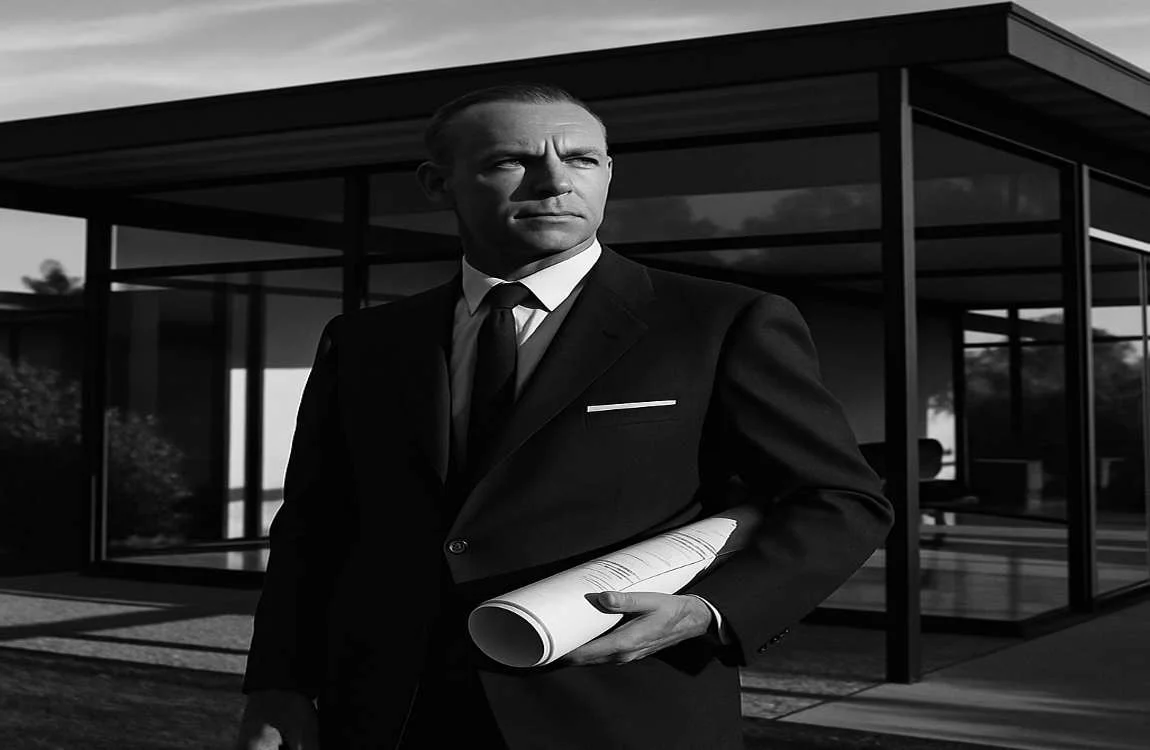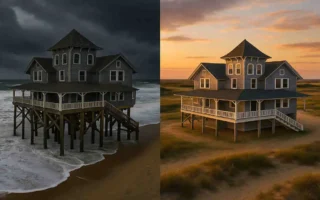Malibu, California, is a place of breathtaking coastlines, celebrity mansions, and some of the most iconic architectural masterpieces in the world. Among its many gems lies a true modernist treasure: the Hunt House Malibu. Designed by the legendary architect Craig Ellwood, this home stands as a testament to mid-century modern design, blending simplicity, innovation, and nature in perfect harmony.
Whether you’re an architecture enthusiast, a design lover, or simply curious about Malibu’s hidden treasures, this is one story you won’t want to miss.
Who Was Craig Ellwood?

To truly appreciate the Hunt House Malibu, we must first understand the man behind its creation: Craig Ellwood.
A Visionary of Modernist Architecture
Craig Ellwood, born Jon Nelson Burke in 1922, was one of the most influential figures of modernist architecture in the mid-20th century. Although not formally trained as an architect, Ellwood’s work earned him a reputation as a visionary, blending art, engineering, and innovation into his designs. His projects embraced the philosophy of “less is more,” emphasizing clean lines, open spaces, and a seamless connection between indoor and outdoor environments.
You may also read (the surprising benefits of hostile home architecture).
Ellwood’s Philosophy
Ellwood’s architectural Style was deeply rooted in modernism, inspired by figures like Mies van der Rohe and Richard Neutra. His designs often featured steel structures, glass walls, and minimalist aesthetics—a combination that aimed to create functional yet visually striking spaces. For Ellwood, architecture wasn’t just about building houses; it was about creating art that people could live in.
Ellwood’s Legacy in California
Craig Ellwood’s work left a profound impact on Southern California’s architectural landscape. His designs, including the Hunt House Malibu, remain iconic examples of mid-century modernism, celebrated for their timeless appeal and innovative use of materials. The Hunt House, in particular, embodies Ellwood’s genius and continues to inspire architects and designers around the world.
The History of The Hunt House Malibu

A Commission for the Hunt Family
In 1957, Craig Ellwood was commissioned by the Hunt family to design a home in Malibu, California. The Hunts wanted a residence that embraced the natural beauty of the location while reflecting the modernist ideals of the time. Ellwood delivered precisely that, creating the Hunt House Malibu, a structure that seamlessly integrated with its surroundings and stood as a bold statement of mid-century design.
You may also read (exploring the concept of datum in home architecture).
Construction and Reception
Completed in 1958, the Hunt House Malibu was an instant architectural marvel. Its use of steel and glass, combined with its open-plan layout, showcased Ellwood’s innovative approach to home design. The house received widespread acclaim and was featured in architectural publications as a prime example of modernism’s potential.
Preservation and Current Status
Over the decades, the Hunt House Malibu has remained remarkably well-preserved. Thanks to its timeless design and careful maintenance, it continues to serve as both a private residence and a piece of architectural history. While modern homes have evolved, the Hunt House remains an enduring symbol of mid-century modernism.
Architectural Style and Design Concept
A Marriage of Modernism and Minimalism
At its core, the Hunt House Malibu embodies the principles of modernism: simplicity, functionality, and harmony with nature. Ellwood’s design strips away unnecessary ornamentation, focusing instead on clean lines, open spaces, and the relationship between the home and its surroundings.
Structural Innovations
One of the most remarkable aspects of the Hunt House is its use of materials. Ellwood employed a steel frame, which allowed for expansive glass walls and an open-plan interior. This structural innovation not only maximized natural light but also created a sense of transparency, blurring the boundaries between indoors and outdoors.
Integration with Nature
Set against the stunning backdrop of Malibu’s coastline, the Hunt House was designed to complement its environment. The house’s low profile and cantilevered roof blend seamlessly with the natural landscape, while its floor-to-ceiling windows provide uninterrupted views of the ocean.
Key Design Features
- Cantilevered Roof: A striking architectural element that adds both visual interest and structural functionality.
- Floor-to-Ceiling Windows: These create a sense of openness and allow for breathtaking views of the Malibu coastline.
- Open-Plan Layout: The interconnected living spaces reflect Ellwood’s belief in functional, flexible design.
Interior Features and Layout
A Functional Yet Elegant Layout
The interior of the Hunt House Malibu is a masterclass in efficiency and elegance. The home’s open-plan design connects the living, dining, and kitchen areas, creating a sense of flow and spaciousness. Each room is thoughtfully positioned to maximize natural light and ocean views.
Materials and Finishes
Ellwood’s use of materials inside the house mirrors the simplicity of its exterior. The interiors feature polished concrete floors, exposed steel beams, and wooden accents, all of which contribute to a warm and inviting atmosphere. These materials were chosen not only for their aesthetic appeal but also for their durability and functionality.
Furniture and Decor
The decor of the Hunt House Malibu reflects the mid-century modern aesthetic, with minimalist furniture, clean lines, and a focus on functionality. While the original furnishings may have evolved over time, the home’s design remains a perfect canvas for modernist decor.
The Hunt House Malibu in Contemporary Architecture
A Lasting Influence
The Hunt House Malibu has left an indelible mark on the world of architecture. Its innovative design continues to inspire contemporary architects, particularly those who embrace the principles of modernism. The home’s emphasis on simplicity, functionality, and harmony with nature serves as a blueprint for countless modern homes today.
Comparisons with Other Iconic Homes
When compared to other mid-century modern homes, the Hunt House Malibu stands out for its seamless integration with its environment. Similar to Richard Neutra’s designs or the Case Study Houses, Ellwood’s work prioritizes a connection to nature while maintaining a sleek, modern aesthetic.
Testimonials and Praise
Architectural critics and historians have often praised the Hunt House Malibu for its timeless design. It’s regarded as one of Ellwood’s finest works and a shining example of mid-century modernism at its best.
Visiting and Experiencing The Hunt House Malibu
Can You Visit the Hunt House?
Unfortunately, the Hunt House Malibu is a private residence and not open to the general public. However, its architectural significance makes it a must-know landmark for anyone visiting Malibu. Architecture lovers can still admire its design from a distance and explore the surrounding area for similar mid-century gems.
Enhancing the Experience
Malibu’s natural beauty adds to the allure of the Hunt House. The coastal environment, with its sandy beaches and rolling waves, complements the home’s design and provides a serene backdrop for its architecture.
Nearby Attractions
If you’re in Malibu, there are plenty of other architectural and natural attractions to explore. These include the Getty Villa, the Adamson House, and various Malibu beaches that showcase the perfect blend of nature and design.
Why The Hunt House Malibu Remains Iconic
Unique Qualities
What makes the Hunt House Malibu so iconic? Its timeless design, innovative use of materials, and seamless integration with its surroundings make it a standout example of mid-century modernism. It’s not just a house—it’s a work of art.
Emotional Connection
Beyond its architectural significance, the Hunt House represents a lifestyle and philosophy that values simplicity, harmony, and connection to nature. It’s a reminder of the beauty that can be achieved when design and environment work together.
A Lasting Legacy
As one of Craig Ellwood’s most celebrated works, the Hunt House Malibu continues to inspire and educate architects, designers, and homeowners alike. Its legacy is a testament to the enduring appeal of modernist design.
How The Hunt House Inspires Modern Home Design
Lessons for Architects and Homeowners
Architects and homeowners alike can learn valuable lessons from the Hunt House Malibu. Its focus on simplicity, functionality, and integration with nature serves as a guide for creating spaces that are both beautiful and practical.
Incorporating the Style
If you’re inspired by the Hunt House, consider incorporating elements of its design into your own home. This might include:
- Using open-plan layouts to create a sense of flow.
- Incorporating floor-to-ceiling windows for natural light and views.
- Selecting materials like steel, glass, and wood for a modern yet timeless aesthetic.
Conclusion
The Hunt House Malibu is more than just a home—it’s a masterpiece of modernist architecture, a symbol of mid-century innovation, and a testament to the genius of Craig Ellwood. Its timeless design continues to inspire architects and homeowners, reminding us of the beauty that can be achieved when simplicity, functionality, and nature come together.
For architecture enthusiasts, the Hunt House Malibu is a must-know landmark, a shining example of what modernism can achieve. Whether you’re exploring Malibu’s architectural gems or looking to bring a touch of mid-century modernism into your life, the Hunt House is sure to leave a lasting impression.
What are your thoughts on the Hunt House Malibu? Share your insights or explore more about Craig Ellwood’s masterpieces—there’s always more to discover in the world of architecture.
You may also read (why everyone is talking about angie house in 2025).



